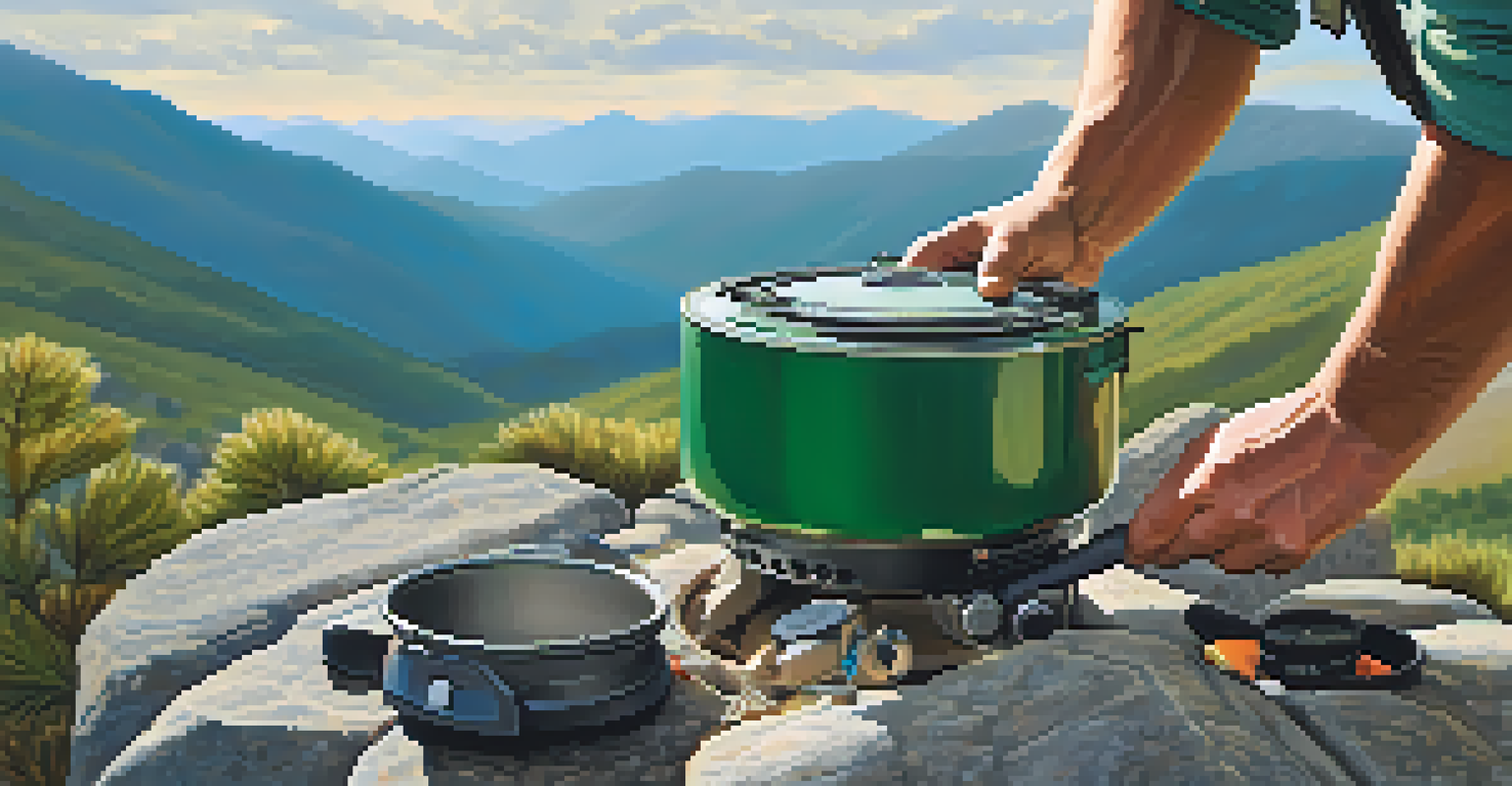Essential Gear for Backpacking in the Great Outdoors

Choosing the Right Backpack for Your Adventure
A good backpack is your best friend on a backpacking trip. It should be comfortable, fit well, and have enough capacity for all your gear. Look for adjustable straps and a hip belt to distribute weight evenly, making long hikes more manageable.
The greatest adventure is what lies ahead.
Consider the size of your backpack based on the length of your trip. A 50-70 liter pack is ideal for multi-day excursions, while a smaller 30-50 liter option works well for day hikes. It's essential to pack smartly to ensure you have everything you need without overloading yourself.
Don’t forget to test your backpack before hitting the trails. Load it up with gear, wear it around the house, and see how it feels. The right fit can make a world of difference in your comfort and enjoyment outdoors.
Investing in a Quality Tent for Shelter
A quality tent protects you from the elements and provides a safe place to rest. Look for lightweight options that are easy to set up and pack away, especially if you’re planning to move campsites frequently. A good tent should also be waterproof and durable.

When selecting a tent, consider the weather conditions you might encounter. Three-season tents are suitable for spring, summer, and fall, while four-season tents are designed to withstand harsher winter conditions. Your choice will ultimately depend on your adventure's timing and location.
Choose the Right Backpack Size
Selecting the appropriate backpack size based on your trip length is crucial for comfort and efficiency.
Don’t overlook the importance of a footprint or ground tarp, which can extend your tent’s life by protecting it from sharp rocks and moisture. A little extra planning can save you from an uncomfortable night out in the wild.
Sleeping Gear: Sleeping Bag and Pad Essentials
A good night’s sleep is crucial when you’re backpacking, and that starts with a quality sleeping bag. Choose a bag rated for the lowest temperature you expect to encounter, and consider options with insulation types like down or synthetic. Each has its pros and cons regarding weight and warmth.
In every walk with nature one receives far more than he seeks.
Pair your sleeping bag with a sleeping pad for added comfort and insulation from the cold ground. Inflatable pads provide great cushioning and pack down small, while foam pads are lightweight and durable. Finding the right combination can make your rest much more rejuvenating.
Don’t forget to roll up your sleeping gear properly to save space in your backpack. If you’re short on packing skills, there are plenty of tutorials online to help you master the art of efficient packing.
Cooking Gear: Portable Stove and Cookware
Cooking gear is essential for preparing meals in the great outdoors, and a portable stove is a must-have. Look for lightweight options like canister stoves or multi-fuel stoves, which are easy to use and pack. They’ll make boiling water or cooking up a meal a breeze after a long day of hiking.
Don’t forget about cookware! A compact pot, a pan, and some utensils will go a long way in ensuring you can whip up delicious meals. Lightweight, non-stick options are great for easy cleaning, and many sets come with the necessary tools included.
Invest in Quality Camping Gear
Quality gear like tents and sleeping bags significantly enhances your outdoor experience and ensures safety.
Consider bringing along a portable coffee maker or a French press if you can’t start your day without a good brew. A warm cup of coffee while soaking in the views can be a perfect start to your morning.
Navigation Tools: Maps, Compass, and GPS
Navigating in the great outdoors requires the right tools. Even if you have a GPS device, carrying a physical map and compass is wise as they don’t rely on batteries. Familiarize yourself with using these tools before you head out to ensure you can find your way, even in the thickest of forests.
A smartphone with a reliable hiking app can be a great addition, but remember to bring a portable charger as a backup. Technology can fail, and being prepared with traditional navigation methods is always wise.
Practice using your navigation tools in familiar areas before venturing into more challenging terrain. This way, you’ll feel confident and ready to explore when it’s time to hit the trails.
Clothing: Layering for Comfort and Weather Protection
When it comes to clothing for backpacking, layering is key. Start with moisture-wicking base layers to keep sweat away from your skin, followed by insulating layers like fleece or down to retain warmth. Finally, top it off with a waterproof and breathable outer layer to protect against rain and wind.
Don’t forget about accessories! A good hat, gloves, and scarf are crucial for keeping you warm, especially in cooler temperatures. Proper footwear is also essential; invest in sturdy hiking boots that provide good support and traction.
Stay Hydrated with Preparation
Planning your water sources and carrying reliable filtration methods is essential for staying hydrated on hikes.
Remember, the weather can change quickly in the great outdoors, so being prepared with the right clothing can make all the difference in your adventure. Comfort and protection should always be your priority.
First Aid Kit: Safety Essentials for Every Trip
A well-stocked first aid kit is a non-negotiable part of your backpacking gear. It should include essentials like band-aids, antiseptic wipes, pain relievers, and any personal medications you might need. Having these supplies on hand can make a significant difference in case of minor injuries or ailments.
Consider adding items like blister treatments, insect repellent, and sunscreen to your first aid kit. These can help prevent and treat common outdoor issues, ensuring you can enjoy your adventure without unnecessary discomfort.

Before you head out, familiarize yourself with the contents of your first aid kit and how to use them. Knowing what to do in an emergency can boost your confidence and safety while exploring the great outdoors.
Hydration: Water Filters and Storage Solutions
Staying hydrated is vital when you’re out in nature, and having a reliable water source is essential. Water filters or purification tablets can help you safely drink from streams and lakes, ensuring you stay refreshed throughout your hike. Look for lightweight options that are easy to use.
In addition to filtration, don’t forget about proper water storage. A good hydration bladder or water bottles that are easy to carry and access will keep you hydrated on the go. Remember to drink regularly, especially during strenuous hikes.
Planning your water supply is crucial, so research the trails you’ll be hiking to know where water sources are located. Being prepared can help you avoid dehydration and keep your energy levels up.